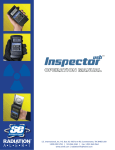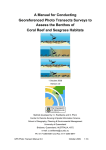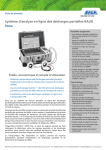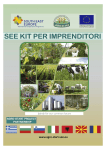Download user manual
Transcript
Supplementary field manual, with recording forms, to be used in conjunction with the lichen-based index guide for determining nitrogen air quality This field manual includes: • Two field recording forms (Site summary and lichen recording forms) that can be downloaded from http:// www.apis.ac.uk/guide-using-lichen-based-index-assessnitrogen-air-quality • Lichen recording form to be used in the field to score the presence or absence of lichens on branches and trunks. It lists the nine N-sensitive and eight N-tolerant lichen taxa. • Worked example of the lichen recording form which illustrates how a recording sheet should look if completed according to instructions described in the guide. Separate forms for recording trunks and branches are included. • Site summary form, which records site information and a summary of the LIS and NAQI scores. • Worked example, that can be used to summarise the recorded data on sensitive and tolerant lichens and record important site specific information e.g. grid ref/, altitude, overall impression of site vegetation health). • Short background synopsis of the research study by Jason Lewis in collaboration with CEH, The Natural History Museum and the University of Nottingham (http:etheses. nottingham.ac.uk/3573) that identified, tested and developed the N air quality index based on epiphytic lichens growing on trunks and branches of oak and birch trees. • Lewis (2012) identified two functional groups: lichens that are sensitive (N-sensitive) to increasing concentrations of atmospheric N and those that are tolerant (N-tolerant). Indicator lichens were selected from leafy, bushy and crustose lichen taxa growing on trunks and branches of oak and birch trees (see Figure 1) across Britain at sites where concentrations of atmospheric nitrogen were routinely measured or measured during one year of the study. Commonly occurring lichen species were recorded and evaluated for their response to different forms of atmospheric nitrogen, namely reduced N, dry deposited ammonia gas and oxides of nitrogen. This presence and absence data was used to select lichen taxa that were tolerant of, or sensitive to increasing concentrations of atmospheric nitrogen. In the context of drawing up a lichen based index that reflects the concentration range of N pollutants present in the local atmosphere indicator lichens needed to be not only tolerant or sensitive but also widely distributed and most importantly, easily identifiable, i.e. a sensitive lichen should not be readily confused with a tolerant lichen. On the basis of such characteristics the list of potential indicator lichens was reduced down to eight N tolerant and nine N sensitive indicators. Identification of lichens Indicator lichens can be classified into 3 distinct types: bushy or fruticose lichens that are only attached to the substrate at the base; leafy or foliose lichens that are loosely attached by rootlet like structures called rhizines and crustose or granular lichens that resemble a skin that you cannot remove from the bark (Figures 1and 2). FAQs (Frequently asked questions) – which might arise during the field survey. The fold-out hard copy Lichen Guide can be purchased from the FSC (http://www.field-studies-council.org/publications/ pubs/guide-to-using-a-lichen-based-index-to-nitrogen-airquality.aspx) and a low resolution pdf can be downloaded from the APIS website (http://www.apis.ac.uk/guide-usinglichen-based-index-assess-nitrogen-air-quality). Indicator lichens Bushy lichen Leafy lichen (green) Bushy lichen Lichens as indicators of nitrogen air quality How and why were the indicator epiphytic species and their host substrate selected? Leafy lichen (brown) Epiphytic lichens growing throughout Europe have been shown to be good indicators of nitrogen air quality (Davies et al 2007, van Herk, 1999, Pinho et al. 2011, Wolseley et al. 2006, 2010, Seed at al. 2013). Crustose lichen 5cm Figure 1. Branch showing the three different types of lichen (leafy, bushy and crustose). 1 Indicator lichens used in this guide fall into three growth forms: Chemical tests can be used to help confirm lichen identification Lichens may contain a great variety of chemical compounds, mainly produced by the fungal partner to protect the algal photobiont from adverse conditions caused by high sunlight, UV or drought. These compounds may be highly coloured as in the bright yellow N-tolerant species of Xanthoria or detected using a simple spot test that produces a distinct colour reaction in some species. If you are unsure of the identity of a species a spot test using household bleach may help. Follow the instructions provided in the guide and make sure that the colour response is correct. Remember that negative reactions are as informative as positive ones. 1. Bushy lichen Attached to the bark at the base Branched and shrub-like, attached to the bark at the base. Branches rounded in section or strap-like with a distinct upper and lower surface. 2. Leafy lichen What the index tells us about pollution levels at a site Information on gaseous N concentrations was collected at the 29 sites where the lichen species composition was evaluated by Lewis, 2012. The lichen composition was correlated with a range of gaseous pollutant concentrations. Attached to the bark from the lower surface The Field Manual is designed to provide a LIS index as an indicator of nitrogen air quality in a given location. It has been correlated with mean gaseous ammonia (NH3) and nitrogen dioxide (NO2) concentration data. A description of N sources can be found on the APIS (air pollution information system) website http://www.apis.ac.uk/ overview/pollutants/overview sources.htm Leaf-like lobes closely or loosely attached to the bark from the lower surface. 3. Crustose or granular lichen What it doesn’t tell us It was not possible to evaluate wet N deposition (i.e. N in precipitation, cloud or dew) effects by the methods used by Lewis (2012). The indicator species and guide were developed from dry deposition, gaseous atmospheric concentrations alone. Likewise the index does not discriminate between oxides of N and ammonia as both are often present. However, because concentrations of N oxides are less spatially variable except close to local sources their concentrations can be readily obtained from the APIS ‘Search by location’ tool (http://www.apis.ac.uk/search-by-location). Closely attached to the bark and cannot be removed without cutting the bark Figure 2. Schematic diagram of the three different types of lichen. Visible features of indicator lichens that can be used in their identification: Why would I want to know about concentrations of gaseous N pollutants at a site? Familiarise yourself with the terms in the glossary, referring to features found in lichens, such as the thallus or the body of the lichen, vegetative propagules, soredia and isidia produced as a mechanism for distributing the photobiont (alga) and fungus together. Fruiting bodies produce the spores of the fungus. The species in this guide may produce cup-shaped (see Xanthoria) or elongated (see Graphis and Arthonia) fruiting bodies. If you have fruiting bodies on your specimen, check that the species and fruiting body match their description and photograph. A brief glossary is provided in the guide and a fuller glossary is available on the web at http://www.nhm.ac.uk/nature-online/life/plantsfungi/lichen-id-guide/glossary.dsml Conducting the lichen survey following the protocol outlined in the guide and expanded on in this manual will enable you to evaluate the risk from N pollution damage to sensitive vegetation growing at a site. APIS also provides habitatpollutant records that provide more information on impacts (http://www.apis.ac.uk/search-pollutant-impacts). Together this field manual and guide describe how surveying species/genera of epiphytic lichens growing on oak and birch can be used to estimate gaseous N concentrations in their immediate locality. 2 How to survey in the vicinity of a N pollution source (intensive animal husbandry units i.e. poultry, pig, dairy) The survey What type of sites can be surveyed? The selection of sampling method depends on your objectives. If you want to establish the concentration gradient away from source to your point of interest you can use the transect approach. Alternatively you may want to establish the N concentration at different points around the point source. The survey can be carried out in a wide variety of urban and rural locations with sufficient trees (five or more) within a reasonably confined area (approx 50 m2). Why are surveys confined to oak and birch trees? Oak and birch trees were chosen for the development of the N index, as they both have rather acid (low pH c. 3-4) bark compared to tree species such as ash and sycamore which have a higher bark pH with lime trees in between. Bark pH changes in response to atmospheric nitrogen deposition and this affects the lichen communities colonising the bark. In most cases atmospheric nitrogen causes an increase in bark pH and trees with a higher bark pH are more likely to support nitrogen-tolerant species of lichen. Trees with a low bark pH tend to support nitrogen-sensitive lichen species and this index measures the change from a nitrogen sensitive to a nitrogen tolerant lichen community, if there is a change in N pollution. This means that surveying trees that naturally have a higher bark pH is likely to produce different results from those with a low bark pH. If using the transect approach it is important to1. Establish the prevailing wind direction. The transect should be sited downwind of the point source, with an upwind background site. The distance and location of this background site will be influenced by the proximity of other point sources. 2. Identify accessible trees and work out the distances from the pollutant point source prior to sampling. 3. Have a greater frequency of sampling locations closer to the point source, as the ammonia concentration decreases exponentially with distance from the N source. Ammonia concentrations can be measured at background levels within c. 250-350 metres from the source. Do I get different results with trunks compared with branches: when and why? A useful link is The Simple Calculation of Atmospheric Impact Limits (SCAIL) model http://www.scail.ceh.ac.uk/ which provides a suite of screening tools for assessing the impact from agricultural and combustion sources on seminatural areas. Epiphytic lichens tend to be slow-growing and long-lived so that lichens growing on older trunks may have become established under different atmospheric conditions to those on younger branch bark. Lichens on branches are recent colonisers and thus reflect the present atmospheric conditions. In areas where atmospheric conditions have changed recently the observed lichen species on trunks and branches may be different. Where local atmospheric N concentrations have increased, the LIS score may be lower on the branches than on the trunks where the LIS score may be higher due to the survival of N-sensitive species. Tree density and shade In areas formerly affected by SO2 (sulphur dioxide) older trunks may continue to have a reduced number of lichens due to the legacy effect. Branches on these trees however, may have grown under a different chemical environment, less influenced by sulphur and are likely to support a different lichen community (Wolseley et al. 2006). When sampling on branches, the three zones are designed to accommodate substrates of different ages. The zones are designated by distance from the growing tip with zone 1 closest to the trunk. You may also find it easier to sample from zone 1 (the older section) first where lichens are older, larger and easier to identify. 3 • Lichens grow best in sunny exposed conditions. In highly shaded conditions they tend to be replaced by algae and bryophytes. Preferably the site you want to evaluate should have several exposed standard trees of the same species, with at least some branches that you can reach (Figure 2). • Avoid sampling damaged trees or trees covered in ivy as both factors alter the bark conditions and also the lichen communities. • When sampling on branches where possible choose the exposed sunny side of the tree and avoid shaded branches. Choose accessible branches from the same tree species if not accessible from the same tree where you sampled the trunk. • How many trees should be sampled? A minimum of 5 trees is recommended but surveying 10 trees would be preferable. Sampling more trees reduces the impact of unrepresentative results. Three trees is the absolute minimum needed, but results for birch and oak e.g.3 birch and 2 oak, can be combined without affecting the LIS. How to record indicator lichens on trunks • Familiarise yourself with the nitrogen indicator (sensitive and tolerant) lichens, and their characteristic features, illustrated in this guide. • Locate a 50 x 10 cm area on each of the three aspects of the tree between 1.0 and 1.5 m above ground level. • Restrict your recording to lichens listed in the guide and included in the downloadable recording forms. Ignore all other lichen species that may be present. • Fill in the recording form, adding a 1 (present) against each N-sensitive and N-tolerant taxa growing between 1 m and 1.5 m above ground level on each of the three aspects (E, S & W) within the 50 x 10 cm area (Figure 4). Figure 5. Three sampling zones along a branch. Glossary A glossary of useful terms can be found at http://www.nhm. ac.uk/nature-online/life/plants-fungi/lichen-id-guide/glossary. dsml Site Summary and Lichen recording forms with completed examples Instructions for filling in the Site Summary and Lichen recording forms Figure 3. Tree selection and sampling height. Figure 4. Selection of three aspects, east, south, west but not north. How to record indicator lichens on branches • Go to the site you want to evaluate for gaseous N concentrations. Check first it is not on limestone http://maps.bgs.ac.uk/soilportal/wmsviewer.html • Identify five or more oak (Quercus petraea, Q. robur), birch (Betula pendula, B. pubescens) trees or a mixture of the two species in a similar situation, not densely planted, shaded, not ivy-covered or damaged. • Select five trunks each single-stemmed and >40 cm girth • Complete site information on Lichen recording forms (Form 1 trunks; Form 2 branches) • Familiarise yourself with the nitrogen indicator (sensitive and tolerant) lichens, and their characteristic features, illustrated in this the guide. • For trunks-record presence or absence of lichens in wide strips (10 x 50 cm) between 1.0 and 1.5 m from the ground, in each of three aspects, East, South and West. • Locate the zones along the selected branch. • • Restrict your recording to lichens listed in the guide and included in the downloadable recording forms. Ignore all other lichen species that may be present. For branches- If available select 3-5 accessible branches and record zone 1 (100-150 cm back from the tip), zone 2 (50-100 cm), and zone 3 (0-50 cm). • Record the presence of each species (not abundance) on Lichen recording form (Form 1). • Transfer data from the lichen recording form to the Site summary form (Form 3). • You can upload your site summary results to the APIS website by completing the online form at http://www. apis.ac.uk/guide-using-lichen-based-index-assessnitrogen-air-quality/upload-results. We will be mapping all completed results to gain a picture of lichen and nitrogen interactions across the UK. You can be part of this story by uploading your results too. • Fill in the recording form, adding a 1 (present) for N-sensitive and N-tolerant taxa growing in each of the three zones (Figure 5). Once you have identified at least one N-sensitive or N-tolerant. There is only a requirement to find one N-sensitive and one N-tolerant lichen species for each zone. The presence/ absence of all the listed lichens does not need to be recorded. Even though you have identified a N-sensitive lichen it is necessary to ensure that there are no N-tolerant lichens present. 4 Suggested methods for marking a 10 x 50 frame on the tree trunks • Large map pins could be used. Caution when using these in case of injury. • A double string with 3 sliding frames between the two strings. The double string 0.5 m apart would be long enough to use on a range of tree trunks (Figure 6). Figure 6. Stringed frame for identifying the three 10 x 50 cm aspects. • a plastic ‘quadrat’ could be made using thick plastic and duct tape. Form 1. Lichen recording form (Trunks) >ŽĐĂƚŝŽŶ dƌƵŶŬ ĂƐƉĞĐƚƐ EͲƐĞŶƐŝƚŝǀĞ dƌĞĞϭ t dƌĞĞϭ ^ dƌĞĞϭ dƌĞĞϮ t dƌĞĞϮ ^ dƌĞĞϮ dƌĞĞϯ t dƌĞĞϯ ^ dƌĞĞϯ dƌĞĞϰ t dƌĞĞϰ ^ dƌĞĞϰ dƌĞĞϱ t dƌĞĞϱ ^ dƌĞĞϱ ƌLJŽƌŝĂĨƵƐĐĞƐĐĞŶƐ ǀĞƌŶŝĂƉƌƵŶĂƐƚƌŝ 'ƌĂƉŚŝƐƐƉĞĐŝĞƐ ,LJƉŽŐLJŵŶŝĂƐƉĞĐŝĞƐ KĐŚƌŽůĞĐŚŝĂĂŶĚƌŽŐLJŶĂ WĂƌŵĞůŝĂƐƉĞĐŝĞƐ WƐĞƵĚĞǀĞƌŶŝĂĨƵƌĨƵƌĂĐĞĂ ^ƉŚĂĞƌŽƉŚŽƌƵƐŐůŽďŽƐƵƐ hƐŶĞĂƐƉĞĐŝĞƐ dŽƚĂů EͲƐĞŶƐŝƚǀĞĐŽƵŶƚƉĞƌĂƐƉĞĐƚ EͲƚŽůĞƌĂŶƚ ƌŵĂŶĚŝŶĞĂƉƵŶĐƚĂƚĂ ƌƚŚŽŶŝĂƌĂĚŝĂƚĂ ĂŶĚĞůĂƌŝĞůůĂƌĞĨůĞdžĂ >ĞĐŝĚĞůůĂĞůĂĞŽĐŚƌŽŵĂ WŚLJƐĐŝĂĂĚƐĐĞŶĚĞŶƐͬƚĞŶĞůůĂ WƵŶĐƚĞůŝĂƐƵďƌƵĚĞĐƚĂ yĂŶƚŚŽƌŝĂƉĂƌŝĞŶƚŝŶĂ yĂŶƚŚŽƌŝĂƉŽůLJĐĂƌƉĂͬƵĐƌĂŝŶŝĐĂ dŽƚĂů EͲƐĞŶƐŝƚǀĞĐŽƵŶƚƉĞƌĂƐƉĞĐƚ 5 Form 2. Lichen recording form (Branches) >ŽĐĂƚŝŽŶ͗ ƌĂŶĐŚĞƐ njŽŶĞƐ EͲƐĞŶƐŝƚŝǀĞ ƌĂŶĐŚϭ ƌĂŶĐŚϭ ƌĂŶĐŚϭ ƌĂŶĐŚϮ ƌĂŶĐŚϮ ƌĂŶĐŚϮ ƌĂŶĐŚϯ ƌĂŶĐŚϯ ƌĂŶĐŚϯ ƌĂŶĐŚϰ ƌĂŶĐŚϰ ƌĂŶĐŚϰ ƌĂŶĐŚϱ ƌĂŶĐŚϱ ƌĂŶĐŚϱ ϭ Ϯ ϯ ϭ Ϯ ϯ ϭ Ϯ ϯ ϭ Ϯ ϯ ϭ Ϯ ϯ ƌLJŽƌŝĂĨƵƐĐĞƐĐĞŶƐ ǀĞƌŶŝĂƉƌƵŶĂƐƚƌŝ 'ƌĂƉŚŝƐƐƉĞĐŝĞƐ ,LJƉŽŐLJŵŶŝĂƐƉĞĐŝĞƐ KĐŚƌŽůĞĐŚŝĂĂŶĚƌŽŐLJŶĂ WĂƌŵĞůŝĂƐƉĞĐŝĞƐ WƐĞƵĚĞǀĞƌŶŝĂĨƵƌĨƵƌĂĐĞĂ ^ƉŚĂĞƌŽƉŚŽƌƵƐŐůŽďŽƐƵƐ hƐŶĞĂƐƉĞĐŝĞƐ dŽƚĂů EͲƐĞŶƐŝƚǀĞĐŽƵŶƚƉĞƌďƌĂŶĐŚ EͲƚŽůĞƌĂŶƚ ƌŵĂŶĚŝŶĞĂƉƵŶĐƚĂƚĂ ƌƚŚŽŶŝĂƌĂĚŝĂƚĂ ĂŶĚĞůĂƌŝĞůůĂƌĞĨůĞdžĂ >ĞĐŝĚĞůůĂĞůĂĞŽĐŚƌŽŵĂ WŚLJƐĐŝĂĂĚƐĐĞŶĚĞŶƐͬƚĞŶĞůůĂ WƵŶĐƚĞůŝĂƐƵďƌƵĚĞĐƚĂ yĂŶƚŚŽƌŝĂƉĂƌŝĞŶƚŝŶĂ yĂŶƚŚŽƌŝĂƉŽůLJĐĂƌƉĂͬƵĐƌĂŝŶŝĐĂ dŽƚĂů EͲƐĞŶƐŝƚǀĞĐŽƵŶƚƉĞƌďƌĂŶĐŚ 6 Examples of completed Forms 1 &2 >ŽĐĂƚŝŽŶ dƌƵŶŬ ĂƐƉĞĐƚƐ EͲƐĞŶƐŝƚŝǀĞ dƌĞĞϭ t dƌĞĞϭ ^ dƌĞĞϭ ƌLJŽƌŝĂĨƵƐĐĞƐĐĞŶƐ dƌĞĞϮ t dƌĞĞϮ ^ dƌĞĞϮ dƌĞĞϯ t dƌĞĞϯ ^ dƌĞĞϯ dƌĞĞϰ t dƌĞĞϰ ^ dƌĞĞϰ dƌĞĞϱ t dƌĞĞϱ ^ dƌĞĞϱ ϭ ǀĞƌŶŝĂƉƌƵŶĂƐƚƌŝ ϭ ϭ ϭ ϭ 'ƌĂƉŚŝƐƐƉĞĐŝĞƐ ,LJƉŽŐLJŵŶŝĂƐƉĞĐŝĞƐ ϭ KĐŚƌŽůĞĐŚŝĂĂŶĚƌŽŐLJŶĂ WĂƌŵĞůŝĂƐƉĞĐŝĞƐ ϭ ϭ ϭ WƐĞƵĚĞǀĞƌŶŝĂĨƵƌĨƵƌĂĐĞĂ ϭ ϭ ϭ ϭ ϭ ϭ ϭ ϭ ^ƉŚĂĞƌŽƉŚŽƌƵƐŐůŽďŽƐƵƐ hƐŶĞĂƐƉĞĐŝĞƐ EͲƐĞŶƐŝƚǀĞĐŽƵŶƚƉĞƌĂƐƉĞĐƚ ϭ ϭ Ϭ ϭ ϭ ϭ ϭ ϭ ϭ Ϭ Ϭ Ϭ ϭ Ϭ ϭ Ϭ ϭ dŽƚĂů ϵ EͲƚŽůĞƌĂŶƚ ƌŵĂŶĚŝŶĞĂƉƵŶĐƚĂƚĂ ƌƚŚŽŶŝĂƌĂĚŝĂƚĂ ĂŶĚĞůĂƌŝĞůůĂƌĞĨůĞdžĂ ϭ >ĞĐŝĚĞůůĂĞůĂĞŽĐŚƌŽŵĂ WŚLJƐĐŝĂĂĚƐĐĞŶĚĞŶƐͬƚĞŶĞůůĂ ϭ ϭ ϭ ϭ ϭ ϭ WƵŶĐƚĞůŝĂƐƵďƌƵĚĞĐƚĂ yĂŶƚŚŽƌŝĂƉĂƌŝĞŶƚŝŶĂ ϭ ϭ yĂŶƚŚŽƌŝĂƉŽůLJĐĂƌƉĂͬƵĐƌĂŝŶŝĐĂ EͲƐĞŶƐŝƚǀĞĐŽƵŶƚƉĞƌĂƐƉĞĐƚ >ŽĐĂƚŝŽŶ͗ ƌĂŶĐŚĞƐ njŽŶĞƐ EͲƐĞŶƐŝƚŝǀĞ ϭ Ϭ Ϭ Ϭ ϭ Ϭ Ϭ ϭ ϭ ϭ ϭ Ϭ Ϭ Ϭ Ϭ ϭ dŽƚĂů ϲ ƌĂŶĐŚϭ ƌĂŶĐŚϭ ƌĂŶĐŚϭ ƌĂŶĐŚϮ ƌĂŶĐŚϮ ƌĂŶĐŚϮ ƌĂŶĐŚϯ ƌĂŶĐŚϯ ƌĂŶĐŚϯ ƌĂŶĐŚϰ ƌĂŶĐŚϰ ƌĂŶĐŚϰ ƌĂŶĐŚϱ ƌĂŶĐŚϱ ƌĂŶĐŚϱ ϭ Ϯ ϯ ϭ Ϯ ϯ ϭ Ϯ ϯ ϭ Ϯ ϯ ϭ Ϯ ϯ ƌLJŽƌŝĂĨƵƐĐĞƐĐĞŶƐ ϭ ǀĞƌŶŝĂƉƌƵŶĂƐƚƌŝ ϭ ϭ ϭ ϭ ϭ ϭ ϭ ϭ ϭ ϭ ϭ ϭ ϭ ϭ ϭ 'ƌĂƉŚŝƐƐƉĞĐŝĞƐ ,LJƉŽŐLJŵŶŝĂƐƉĞĐŝĞƐ KĐŚƌŽůĞĐŚŝĂĂŶĚƌŽŐLJŶĂ WĂƌŵĞůŝĂƐƉĞĐŝĞƐ ϭ ϭ WƐĞƵĚĞǀĞƌŶŝĂĨƵƌĨƵƌĂĐĞĂ ^ƉŚĂĞƌŽƉŚŽƌƵƐŐůŽďŽƐƵƐ hƐŶĞĂƐƉĞĐŝĞƐ EͲƐĞŶƐŝƚǀĞĐŽƵŶƚƉĞƌďƌĂŶĐŚ ϭ ϭ Ϭ ϭ ϭ ϭ ϭ ϭ Ϭ Ϭ ϭ Ϭ ϭ Ϭ ϭ ϭ dŽƚĂů ϭϬ EͲƚŽůĞƌĂŶƚ ƌŵĂŶĚŝŶĞĂƉƵŶĐƚĂƚĂ ϭ ƌƚŚŽŶŝĂƌĂĚŝĂƚĂ ĂŶĚĞůĂƌŝĞůůĂƌĞĨůĞdžĂ >ĞĐŝĚĞůůĂĞůĂĞŽĐŚƌŽŵĂ WŚLJƐĐŝĂĂĚƐĐĞŶĚĞŶƐͬƚĞŶĞůůĂ ϭ WƵŶĐƚĞůŝĂƐƵďƌƵĚĞĐƚĂ yĂŶƚŚŽƌŝĂƉĂƌŝĞŶƚŝŶĂ ϭ yĂŶƚŚŽƌŝĂƉŽůLJĐĂƌƉĂͬƵĐƌĂŝŶŝĐĂ EͲƐĞŶƐŝƚǀĞĐŽƵŶƚƉĞƌďƌĂŶĐŚ ϭ Ϭ Ϭ Ϭ Ϭ ϭ Ϭ Ϭ 7 Ϭ Ϭ ϭ Ϭ Ϭ Ϭ Ϭ ϭ dŽƚĂů ϯ Form 3. Blank Site Summary form >ŽĐĂƚŝŽŶ 'ƌŝĚƌĞĨĞƌĞŶĐĞͬ'W^ ŝ͘Ğ͘EdϮϰϱϲϳϴ ĞůĞƚĞĂƐŶĞĐĞƐĂƌLJ dƌĞĞƚLJƉĞƚƌƵŶŬ ŽĂŬ dƌĞĞƚLJƉĞďƌĂŶĐŚ ŽĂŬ ŽƵŶƚƐŽĨĂƐƉĞĐƚƐ dƌƵŶŬƐ ǁŝƚŚEͲƐĞŶƐŝƚŝǀĞ ůŝĐŚĞŶƐ ŝƌYƵĂůŝƚLJ ůƚŝƚƵĚĞŵ EŽŽĨƚƌƵŶŬƐƐƵƌǀĞLJĞĚ EŽŽĨďƌĂŶĐŚĞƐƐƵƌǀĞLJĞĚ ďŝƌĐŚ ďŝƌĐŚ EŽ͘ŽĨƚƌƵŶŬƐ ƐƵƌǀĞLJĞĚ ǀĞƌĂŐĞƐĐŽƌĞƉĞƌƚƌƵŶŬ ŝ͘Ğ͘ŽƵŶƚͬŶŽ͘KĨƚƌĞĞƐ >/^;EͲƐĞŶƐŝƚǀĞĂǀĞƌĂŐĞ ƐĐŽƌĞŵŝŶƵƐEͲƚŽůĞƌĂŶƚ ĂǀĞƌĂŐĞƐĐŽƌĞ dƌƵŶŬƐ ŽƵŶƚƐŽĨĂƐƉĞĐƚƐ ǁŝƚŚEͲƚŽůĞƌĂŶƚ ůŝĐŚĞŶƐ EŽ͘ŽĨƚƌƵŶŬƐ ƐƵƌǀĞLJĞĚ ǀĞƌĂŐĞƐĐŽƌĞƉĞƌƚƌƵŶŬ ŝ͘Ğ͘ŽƵŶƚͬŶŽ͘ŽĨƚƌĞĞƐ EY/ǀĂůƵĞ͘džƚƌĂĐƚĨƌŽŵ ĨŝŐƵƌĞϰ ƌĂŶĐŚĞƐ ŽƵŶƚƐŽĨnjŽŶĞƐ ǁŝƚŚEͲƐĞŶƐŝƚŝǀĞ ůŝĐŚĞŶƐ EŽ͘ŽĨďƌĂŶĐŚĞƐ ƐƵƌǀĞLJĞĚ ǀĞƌĂŐĞƐĐŽƌĞƉĞƌďƌĂŶĐŚ >/^;EͲƐĞŶƐŝƚǀĞĂǀĞƌĂŐĞ ƐĐŽƌĞŵŝŶƵƐEͲƚŽůĞƌĂŶƚ ĂǀĞƌĂŐĞƐĐŽƌĞ ƌĂŶĐŚĞƐ ŽƵŶƚƐŽĨnjŽŶĞǁŝƚŚ EͲƚŽůĞƌĂŶƚůŝĐŚĞŶƐ EŽ͘ŽĨďƌĂŶĐŚĞƐ ƐƵƌǀĞLJĞĚ ǀĞƌĂŐĞƐĐŽƌĞƉĞƌďƌĂŶĐŚ EY/ǀĂůƵĞ͘džƚƌĂĐƚĨƌŽŵ ĨŝŐƵƌĞϰ You can upload your results to the APIS website by completing the online recording form at http://www.apis. ac.uk/guide-using-lichen-based-index-assess-nitrogen-airquality/upload-results We will be mapping all completed results to gain a picture of the lichen and nitrogen interactions across the UK. You can be part of this story by uploading your results here. Worked example of Site Summary form (Form 3) >ŽĐĂƚŝŽŶ 'ƌŝĚƌĞĨĞƌĞŶĐĞͬ'W^ ŝ͘Ğ͘EdϮϰϱϲϳϴ ĞůĞƚĞĂƐŶĞĐĞƐĂƌLJ dƌĞĞƚLJƉĞƚƌƵŶŬ ŽĂŬ dƌĞĞƚLJƉĞďƌĂŶĐŚ ŽĂŬ ŽƵŶƚƐŽĨĂƐƉĞĐƚƐ dƌƵŶŬƐ ǁŝƚŚEͲƐĞŶƐŝƚŝǀĞ ůŝĐŚĞŶƐ dƌƵŶŬƐ ŽƵŶƚƐŽĨĂƐƉĞĐƚƐ ǁŝƚŚEͲƚŽůĞƌĂŶƚ ůŝĐŚĞŶƐ ŝƌYƵĂůŝƚLJ ůƚŝƚƵĚĞŵ EŽŽĨƚƌƵŶŬƐƐƵƌǀĞLJĞĚ EŽŽĨďƌĂŶĐŚĞƐƐƵƌǀĞLJĞĚ ďŝƌĐŚ ďŝƌĐŚ ϵ EŽ͘ŽĨƚƌƵŶŬƐ ƐƵƌǀĞLJĞĚ ϱ ǀĞƌĂŐĞƐĐŽƌĞƉĞƌƚƌƵŶŬ ŝ͘Ğ͘ŽƵŶƚͬŶŽ͘KĨƚƌĞĞƐ ϵͬϱсϭ͘ϴ >/^;EͲƐĞŶƐŝƚǀĞĂǀĞƌĂŐĞ ƐĐŽƌĞŵŝŶƵƐEͲƚŽůĞƌĂŶƚ ĂǀĞƌĂŐĞƐĐŽƌĞ ϭ͘ϴͲϭ͘ϮсϬ͘ϲ ϲ EŽ͘ŽĨƚƌƵŶŬƐ ƐƵƌǀĞLJĞĚ ϱ ǀĞƌĂŐĞƐĐŽƌĞƉĞƌƚƌƵŶŬ ŝ͘Ğ͘ŽƵŶƚͬŶŽ͘ŽĨƚƌĞĞƐ ϲͬϱсϭ͘Ϯ EY/ǀĂůƵĞ͘džƚƌĂĐƚĨƌŽŵ ĨŝŐƵƌĞϰ ϭ͘Ϭϱ ƌĂŶĐŚĞƐ ŽƵŶƚƐŽĨnjŽŶĞƐ ǁŝƚŚEͲƐĞŶƐŝƚŝǀĞ ůŝĐŚĞŶƐ ϭϬ EŽ͘ŽĨďƌĂŶĐŚĞƐ ƐƵƌǀĞLJĞĚ ϱ ǀĞƌĂŐĞƐĐŽƌĞƉĞƌďƌĂŶĐŚ ϭϬͬϱсϮ >/^;EͲƐĞŶƐŝƚǀĞĂǀĞƌĂŐĞ ƐĐŽƌĞŵŝŶƵƐEͲƚŽůĞƌĂŶƚ ĂǀĞƌĂŐĞƐĐŽƌĞ ϮͲϬ͘ϲсϭ͘ϰ ƌĂŶĐŚĞƐ ŽƵŶƚƐŽĨnjŽŶĞǁŝƚŚ EͲƚŽůĞƌĂŶƚůŝĐŚĞŶƐ ϯ EŽ͘ŽĨďƌĂŶĐŚĞƐ ƐƵƌǀĞLJĞĚ ϱ ǀĞƌĂŐĞƐĐŽƌĞƉĞƌďƌĂŶĐŚ ϯͬϱсϬ͘ϲ EY/ǀĂůƵĞ͘džƚƌĂĐƚĨƌŽŵ ĨŝŐƵƌĞϰ Ϭ͘ϳϴ 8 ƚZŝƐŬ ƚƌŝƐŬ N-tolerant 0 0 0 1 0 0 1 1 1 1 0 0 0 0 1 6 Lichen indicator score (LIS) = (Average N-sensitive) – (Average N-tolerant) 1.2 0.6 ToThe estimate theindicator LIS on branches, Figure 3 for N-sensitive and N-tolerant species on the three lichen scorerepeat (LIS) the andprocess the Nasairin quality zones on five sampled branches. Interpreting your LIS in terms of exposure to gaseous Nitrogen Compounds Sites that are designated as clean have an NAQI between 0 and 0.5, at risk NAQI > 0.5-0.85, N polluted NAQI 0.86-1.25, 3.0 Lichen indicator Score (LIS) The fitted lines are derived from mean values taken from the UK wide survey. The LIS NAQI relationship for branches should be read from the broken line and for trunks from the solid line. Figure 4. Relationship between the Lichen Indicator Score (LIS) and N Air Quality Index (NAQI) 2.0 N polluted Very N polluted 1.0 Branch 0 Trunk -1.0 Clean At risk -2.0 -3.0 0 0.5 1.0 1.5 2.0 N Air Quality Index (NAQI) very N polluted NAQI > 1.25. Calculating your lichen indicator score (LIS) for trunks and branches measured NH3 concentration data and modelled NO2 concentration data. It was mathematically derived to be the best fit for the UK NH3 and NO2 data. NO2 concentrations show much less local spatial variation than NH3 concentrations. Thus if you derive the site NAQI and use the site grid reference to look up the NO2 concentration in APIS (Air Pollution Information System) you can calculate the NH3 The LIS is based on the difference between the presence of N-tolerant and N-sensitive lichens on three aspects of the trunk or zones of the branch. Populate Forms 1 & 2 (worked examples of trunks and branches on page 7) by allocating a score of 1 (presence) for one or more of the listed N-sensitive species. Allocate a score of 0 if N- sensitive species are absent. • • References Count the number of aspects on all 5 trees that support tolerant species. i.e. a maximum value of 15 could be obtained if each of the 5 trees supported a tolerant species on each of the three aspects. concentration by substituting values in the above equation. Davies, L., Bates, J. W., Bell, J. N. B., James, P. W. & Purvis, W. O. (2007). Diversity and sensitivity of epiphytes to oxides of nitrogen in London. - Environmental Pollution 146(2): 299-310. Count the number of aspects on all 5 trees that support sensitive species i.e. a maximum value of 15 could be obtained if each of the 5 trees supported a tolerant species on each of the three aspects. • Divide the count by the number of trees recorded to obtain an average value for both N-sensitive and N-tolerant lichens. • Subtract the average for N-tolerant from the average for N-sensitive to obtain a lichen indicator score (LIS). • Don’t forget to upload your Site Summary results to APIS: http://www.apis.ac.uk/guide-using-lichen-basedindex-assess-nitrogen-air-quality/upload-results Lewis, J.E.J. (2012). Biomonitoring for atmospheric nitrogen pollution using epiphytic lichens and bryophytes. PhD Thesis (http://etheses.nottingham.ac.uk/3573/) Pinho, P., T. Dias, C. Cruz, Y. Sim Tang, M. A. Sutton, M.A. Martins-Loução, C. Máguas & C. Branquinho (2011). Using lichen functional diversity to assess the effects of atmospheric ammonia in Mediterranean woodlands. Journal of Applied Ecology 48(5): 1107-1116. Seed, L., Wolseley, P.A., Gosling, L., Davies, L. & Power, S. (2013). Modelling relationships between lichen bioindicators, air quality and climate on a national scale: results from the UK OPAL Air Survey. Environmental Pollution In press. The NAQI = 2 [NH3]^0.5 + [NO2]^0.5 using µmol,m3 Wolseley, P., James, P. W., Theobald, M. R. & Sutton, M. A. 2006). Detecting changes in epiphytic lichen communities This equation has been derived using modelled and 9 at sites affected by atmospheric ammonia from agricultural sources. - Lichenologist 38(2): 161-176. Yes. Calculation of the site specific index does not require the presence of all 8 + 9 taxa from the tolerant and sensitive functional groups. Realistically it is more likely that you will only find some or even none of the listed species. Wolseley, P., M. Sutton, I. D. Leith & N. van Dijk (2010): Epiphytic lichens as indicators of ammonia concentrations across the UK. - In: T. H. Nash, III, L. Geiser, B. McCune, D. Triebel, A. M. F. Tomescu and W. B. Sanders: Biology of Lichens ― Symbiosis, Ecology, Environmental Monitoring, Systematics and Cyber Applications. Bibliotheca Lichenologica No. 105. J. Cramer in der Gebrüder Borntraeger Verlagsbuchhandlung, Stuttgart. 256 pages, pp.75-85. Can a survey still be undertaken if there are not five suitable trees at the selected site? Yes, but a smaller number can influence your NAQI score and increase level of uncertainty with odd results. Is it necessary to survey both trunks and branches? Frequently asked questions No. Both will give an individual NAQI score but if possible it would be better to survey both, as the lichen present on the trunks may differ from those on the branches. van Herk, CM (1999).Mapping of ammonia pollution with epiphytic lichens in the Netherlands. - Lichenologist 31(1): 9-20. Will the lichens be the same on trunks and branches? Can I conduct a survey if no oak or birch trees are present at the site? Not necessarily. Branch lichens are probably more recently colonised and the lichens present provide a more up to date indication of the N pollution climate. No, the relationship between LIS and NAQI was derived from epiphytic lichens growing on these tree species and has not been tested beyond these host substrates. In addition, only birch or oak that exceed 1.5 m tall (are of sufficient age / size to support lichens), do not support ivy, are healthy and not too densely planted are suitable. WHY? because these factors also influence which lichen species grow on the substrate. Can other lichen species be used apart from the ones listed in the Field Guide? No. The research to calculate the NAQI established that these were the most appropriate indicator species to use. Can a survey be conducted if none of the listed lichen species or taxa are present? How far apart can the individual trees be at a location not obviously impacted by a point source? No. The research to calculate the NAQI establish that these were the most appropriate indicator species to use. If the location is not close to a N point source then the trees could be up to 50 m apart. Is it necessary to identify to species level? How far apart can the individual trees be at a location impacted by a point source? Only for some species but for example, Parmelia species do not need to be identified to species as both Parmelia sulcata and P. saxatilis are considered to be N-sensitive, so it is sufficient to identify that it is one of the Parmelia’s. If using a transect approach, the trees growing at each sampling location must be adjacent to each other (growing in a clump of trees). For sampling locations close to the N source the sample trees should be in close proximity due to ammonia concentrations decreasing exponentially from N source. Is it correct that only one N-sensitive or one N-tolerant species needs to be present to give a score of 1? Yes. Can a mix of oak and birch be used to make up the five trunks or branches surveyed? If there are several of the lichen species on a trunk or branch the score will still be 1? Yes. The objective of the survey is to determine the presence or absence of N-sensitive and N-tolerant species and to calculate a LIS. This can be achieved using a combination of oak and birch trunks and branches. Yes. The maximum score is 3 when an indicator is present on 3 aspects of the trunk or 3 zones of the branch. Fallen branches should not be used for the survey? Can I conduct a survey if only a few of the indicator species are present? 10















